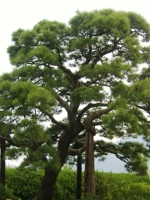Mon-Fri 9am - 5pm Mountain time
Wayfaring Tree vs Japanese Black Pine
Viburnum lantana
Pinus thunbergii
CUSTOM GROW
NOT AVAILABLE THIS SEASON - MIGHT RETURN
Wayfaring Tree is an adaptable and reliable shrub. It is prized for its ornamental berries that can range in color from red to yellow to black. Consider getting two trees as fruiting is maximized when another Wayfaring Tree is present.
This species has a variety of uses ranging from naturalization, mass planting, borders, and privacy screens.
Japanese Black Pine is known for its unique and irregular growth habit, making it a striking landscape addition. It typically does not grow with a central leader. This causes it to form a flat-top, classic bonsai-like shape when mature. When it has a central leader, it will grow with a twisted trunk. Another striking feature is the white apical buds which contrast with the surrounding green needles.
The Japanese Black Pine is an excellent candidate for a bonsai tree and is frequently used by the bonsai community. It is found along the Japanese coast and is salt tolerant.

